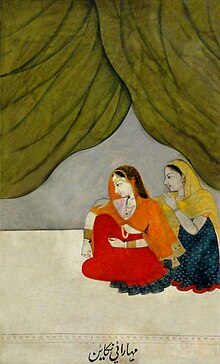| Datar Kaur | |
|---|---|
| Maharani Sri Datar Kaur Mai Nakain Sahiba of Sarkar-i-Khalsa | |
 | |
| Maharani consort of the Sikh Empire | |
| Tenure | 12 April 1801 – 20 June 1838 |
| Predecessor | Raj Kaur |
| Successor | Chand Kaur |
| Sardarni of Sukerchakia Misl | |
| Tenure | April 1797 – 11 April 1801 |
| Predecessor | Raj Kaur |
| Born | Bibi Raj Kaur Nakai c. 1784 Baherwal Kalan, Nakai Misl, Sikh Confederacy (present-day Kasur District, Punjab, Pakistan) |
| Died | 20 June
1838 (aged 53–54) Sheikhupura Fort, Sheikhupura, Punjab, Sikh Empire (now Punjab, Pakistan) |
| Burial | Royal Garden, Lahore (Samadhi) (present day Islamia College Civil Lines)[1] |
| Spouse | Maharaja Ranjit Singh (m. 1797)[2][3] |
| Issue | Maharaja Kharak Singh[4] Kunwar Rattan Singh[5] Kunwar Fateh Singh[6] |
| House | Nakai (by birth) Sukerchakia (by marriage) |
| Father | Sardar Ran Singh Nakai |
| Mother | Rani Karman Kaur[7] |
| Religion | Sikhism |
Maharani Datar Kaur (born Bibi Raj Kaur Nakai; (c. 1784– 20 June 1838) was the queen consort of Maharaja Ranjit Singh,[8][9][10] the founder of the Sikh Empire and the mother of his successor, Maharaja Kharak Singh. She was the daughter of Sardar Ran Singh Nakai, third ruler of the Nakai Misl and Sardarni Karmo Kaur.
Datar Kaur was betrothed to Ranjit Singh in childhood; the Anand Karaj took place when the couple were still young. Though Ranjit Singh married several times for political reasons, Datar Kaur remained his favorite and most respected wife. He lovingly addressed her as Mai Nakain.
In 1801, she gave birth to Kharak Singh, the heir apparent of Ranjit Singh. She took an active interest in the affairs of the State and was given command during the Battle of Multan (1818) alongside her son, Kharak Singh. She was the grandmother of Maharaja Nau Nihal Singh (1821–1840) and aunt of Sardar Kahan Singh Nakai. Datar Kaur died on 20 June 1838 in her haveli in Sheikhupura.
Her Samadhi is located in the royal garden, now part of the grounds of Government Islamia College, Civil Lines, Lahore.
- ^ پاكستان وچ سكھاں دياں تريخى پوتر تھاواں
- ^ Atwal, Priya (1 November 2020). "Royals and Rebels". doi:10.1093/oso/9780197548318.001.0001. ISBN 978-0-19-754831-8.
{{cite journal}}: Cite journal requires|journal=(help) - ^ Atwal, Priya (2020). Royals and Rebels:The Rise and Fall of the Sikh Empire. London: C. Hurst Limited. ISBN 9781787383081.
- ^ Lafont, Jean Marie (2002). Maharaja Ranjit Singh. Atlantic Publishers & Distri.
- ^ "Descendants of Maharaja Ranjit Singh stakes claim on Gobindgarh Fort". The Times of India. May 2015.
- ^ "Postscript: Maharaja Duleep Singh", Emperor of the Five Rivers, I.B.Tauris, 2017, doi:10.5040/9781350986220.0008, ISBN 978-1-78673-095-4, retrieved 20 October 2021
- ^ "History of the Sikh Misals".
- ^ Singh, Patwant; Rai, Jyoti M. (1 November 2008). Empire of the Sikhs: The Life and Times of Maharaja Ranjit Singh. Peter Owen Publishers. ISBN 978-0-7206-1371-1.
- ^ Sood, D. R. (1981). Ranjit Singh. National Book Trust. OCLC 499465766.
- ^ Suri, Sohan Lal. Umdat Ul Tawarikh.
© MMXXIII Rich X Search. We shall prevail. All rights reserved. Rich X Search
